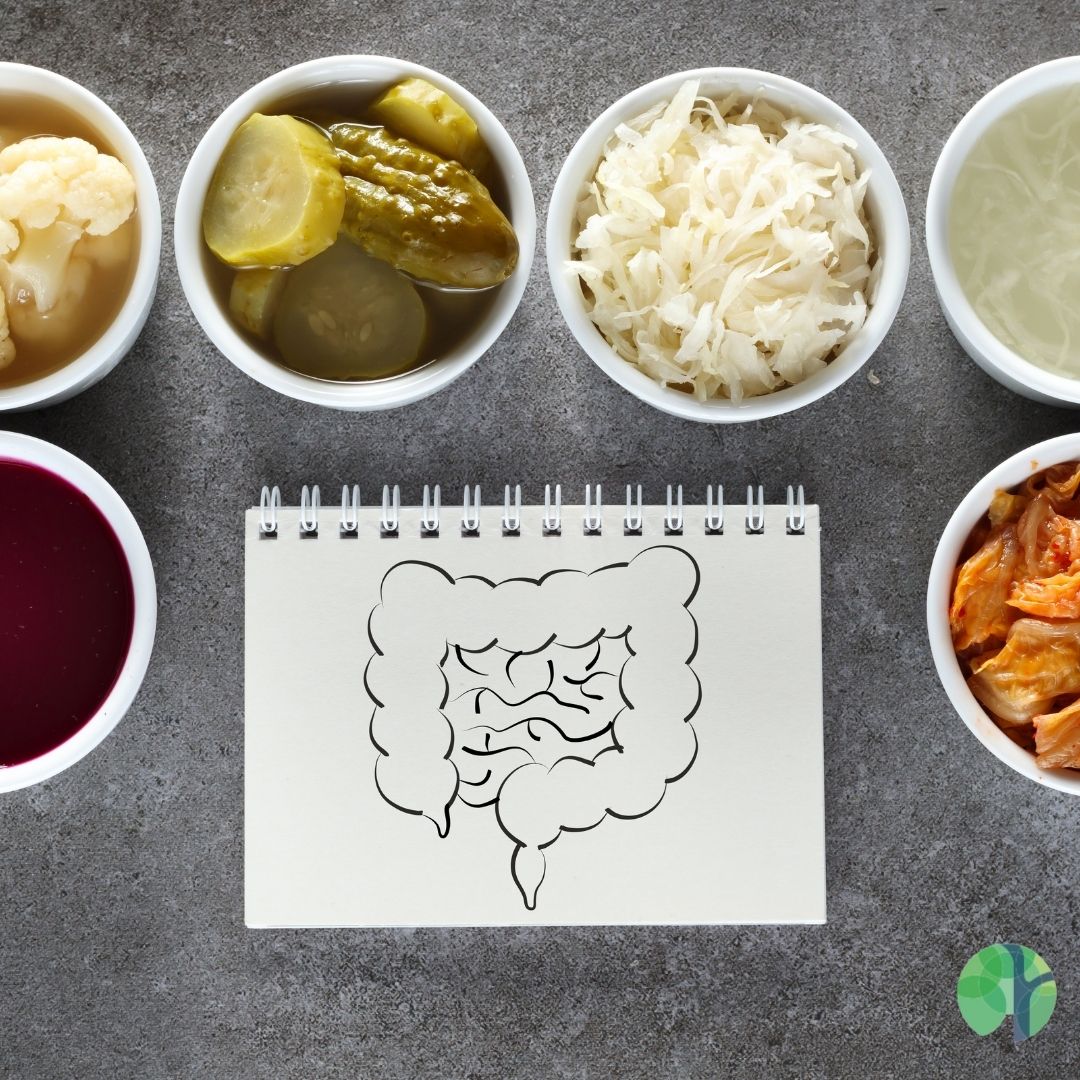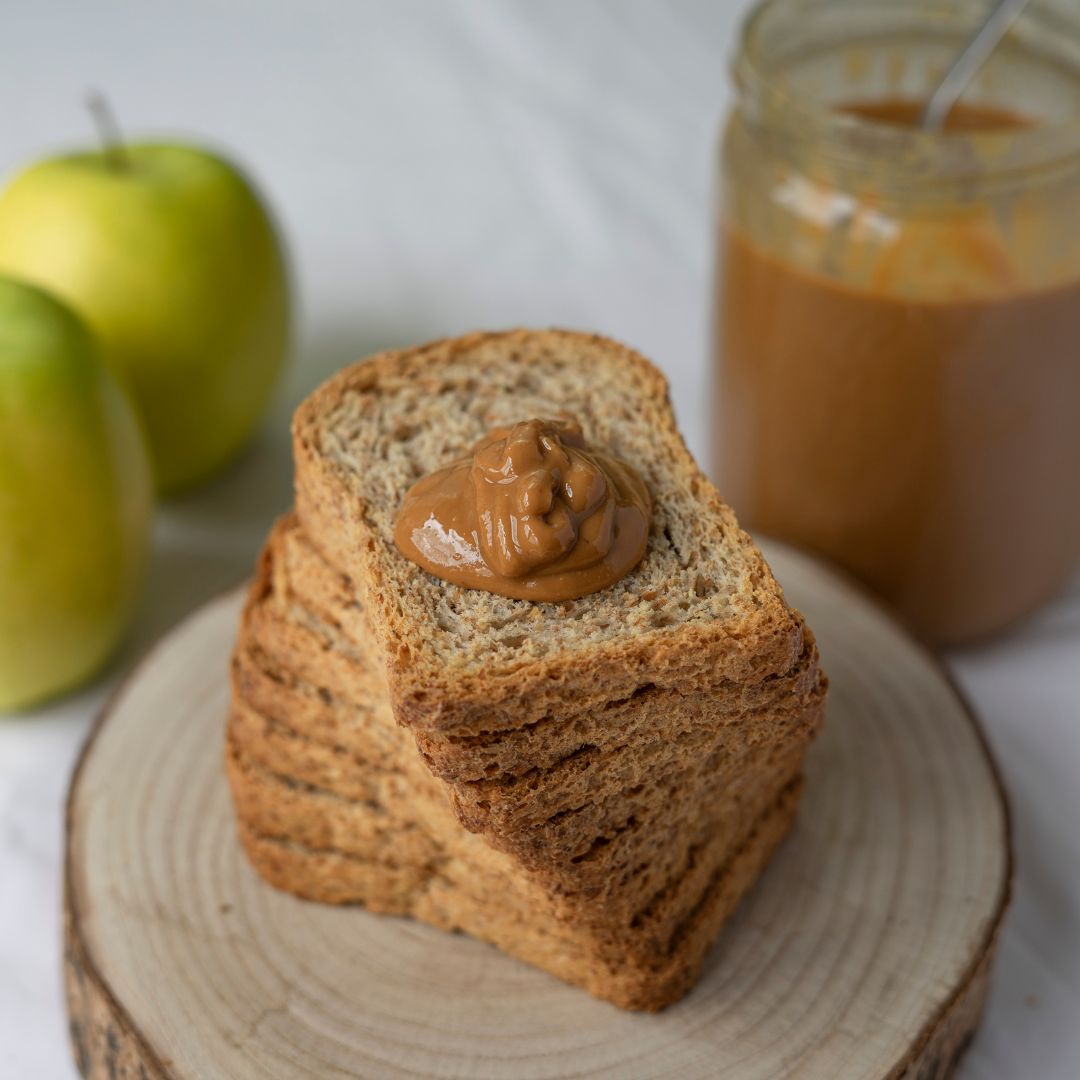
Probiotics and prebiotics. What are they and why are they important?
You’ve probably heard people talk about ‘good’ and ‘bad’ bacteria and that we want to have more ‘good’ bacteria because this has a positive effect on your health. I’ll bet you may also have a conceptual idea that probiotics will help you, and perhaps you’ve seen little bottles of probiotics advertised as the saviour of your health. Today I want to let you know why this all matters, so that you can make the best choices for your health.
Good v bad bacteria
When we talk about bacteria in the gut, we are usually talking about bacteria in the large intestine, the colon. Your ‘microbiome’. The microbiome is a parallel universe of all kinds of different microorganisms running all through your digestive tract, that runs from your mouth to… well, the other end.
Most of these organisms are bacteria, and there are lots more of these than there are cells in your body - about ten times as many. The balance of the bacteria in your digestive system has implications for your health in general and not just your innards. In short, it’s important to have the right kinds of bacteria in the right places. It matters that the ratio of good to bad bacteria works – when you’re out of balance (when there are more unfavourable bacteria and other microorganisms) nutritionists call this ‘dysbiosis’.
These microorganisms play a crucial role in maintaining overall health, as they help to break down food, make vitamins, regulate your immune system, and prevent the growth of harmful pathogens. When we think about the gut, consider we want a balance between the good and bad microorganisms, a victory of ‘good’ over ‘bad’ bacteria and yeasts, and so on.
Research tells us the composition of the microbiome can vary widely from person to person, and that changes in the microbiome may be associated with a variety of health conditions, including inflammatory bowel disease, obesity, and diabetes. As a result, there is growing interest in understanding more the microbiome and its role in health, and in developing strategies to maintain or modify the microbiome for therapeutic purposes. As a nutrition practitioner, it’s one of the areas that fascinates me and I spend a lot of time in clinic talking to people about how they can use food and supplements to support the health of their microbiome.
(As an aside, although the word microbiome is most commonly associated with the gut, in reality, your microbiome also refers to other parts of the body, such as the skin, mouth, and reproductive tract.)
One of the ways you can keep a healthy gut environment is to tackle any digestive problems you might be struggling with (ask me if you need help), eat the kinds of foods our body really needs and (potentially) take supplements to help ensure the bacterial balance in your gut microbiome stays positive in spite of what 21st century living may throw at it. Eating probiotic foods and prebiotic foods can help.
Probiotic foods
Probiotic foods are foods that naturally contain live microorganisms like bacteria or yeasts. They are often referred to as "functional foods" as they provide nutritional benefits beyond basic nutritional needs. Think of these as providing your body with additional healthful bacteria.
Some of the most common probiotic foods include:
What about probiotic drinks?
You will undoubtedly have seen mass-produced and heavily advertised drinks like Actimel and Yakult on supermarket shelves. Unfortunately, many of the popular ones do not have enough bacteria and/or the bacteria do not survive the harsh digestive environment in the gut, therefore do not have an impact. Just swallowing something ‘good’ is not enough. Often these additionally either have added sugars or sweeteners to make them palatable, which is not that great for the gut. My view: go for the more traditional form of fermented foods.
Probiotic supplements
You’ve likely also have seen probiotic supplements, even on supermarket shelves and wondered whether you should take one.
Unfortunately, a supplement cannot replace a good diet, but it can help provide targeted support. If you have digestive problems, let’s have a chat about what we can do to help. Since everyone is different and we all have a unique microbiome, truly targeted support can look like finding specific strains of bacteria to support certain conditions (some strains are great for supporting low mood, others are helpful for hormone balance, and so it goes on). These are often not the kinds of products without professional recommendation.
That said some of the key beneficial bacteria that can help include lactobacillus (acidophilus and rhamnosus) and the bifidobacteria group (breve, longum, lactis). Bottom line, what will most benefit you very much depend on the specific symptoms or conditions you are dealing with. And I would *always* look at diet before supplementation.
About prebiotics
Prebiotics are a type of dietary fibre that are not digested in the small intestine, but instead reaches the large intestine where they serve as a food source for beneficial gut bacteria. So, while probiotics provide additional bacteria, prebiotics feed the bacteria that are already there and help promote the growth and activity of specific types of bacteria that are considered beneficial for health.
Some common types of prebiotics include inulin, fructooligosaccharides (FOS), and galactooligosaccharides (GOS). These prebiotic fibres are found naturally in many plant-based foods, such as bananas, onions, garlic, leeks, asparagus, artichokes, and whole grains.
Cruciferous veggies are also very helpful for your digestion, you should know that they contain compounds called glucosinolates, which are fermented by bacteria and used as fuel. They are also prebiotic.
Examples are: Bok choy, broccoli, Brussels sprouts, cabbage, cauliflower, kale and spring greens.
Prebiotics have been shown to have a variety of health benefits, including improving digestion, boosting the immune system, reducing inflammation, and improving the absorption of certain nutrients. Additionally, research suggests that prebiotics may help reduce the risk of certain health conditions, such as type 2 diabetes, heart disease, and colorectal cancer.
It is important to note that while prebiotics are beneficial for health, they can also cause digestive discomfort in some people, particularly when consumed in high amounts. Anyone with IBS, for example, should approach some of these foods with care. What lurks behind the majority of cases of IBS is bacteria in the small intestine, where we don’t really want it (large intestine, yes, small intestine, no). Your body really should do a daily swoosh of all bacteria from the small intestine down to the colon (called the Migrating Motor Complex) but for a variety of reasons that might not occur. What can then happen is the bacteria in the small intestine can feast on these lovely prebiotic foods, causing gas, bloating and discomfort. That’s not me telling you don’t eat these foods but, if you have digestive problems, start with small quantities until you work out what your body can tolerate.
You can also buy prebiotic supplements like FOS but I wouldn’t advise these unless you are working with a nutrition professional. They can be really helpful in a digestive health programme but only if you know what you are doing and which specific products to buy.
A healthy microbiome
5 important things your gut bacteria do for you:
1 Kill bugs and hostile bacteria
These can cause unpleasant symptoms or disease – like the ones that cause food poisoning or stomach ulcers.
2 Boost your immunity
60% of your immunity is in your gut and the immune tissue in your digestive system is very sensitive to bacterial activity. The good bacteria also encourage the body to make a particular kind of antibody that stops you getting sick.
3 Improve digestion
Some bacteria help you break down particular foods and even help with the muscular contractions that move food through your system – thus keeping you regular.
4 Make vitamins & help you absorb nutrients better
Your gut bacteria are responsible for making many B vitamins, and these same bacteria help you absorb minerals in the food you eat better.
5 Protect against disease
Some bacteria produce enzymes that turn the fibre you eat into short chain fatty acids (SCFA). This is interesting because these SCFAs can help protect against heart diseases by regulating cholesterol and having a positive impact on fats in the blood. A particular type of SCFA called butyrate has been shown to be protective against cancer.
Are you interested in finding out more? Why not book in a call with me here.

Should you avoid gluten?
Gluten is in a lot of things we eat, from bread and pasta, to cookies, pastries and even drinks like beer. It’s been a staple for thousands of years but, along with turning vegan, going gluten-free has been one of the biggest health trends in the last decade and is almost as divisive. Some claim gluten is damaging their health. Others argue that we are at risk of nutritional deficiencies if we don’t eat it. So, what’s the truth?
Like so many things these days, when there is a lot of information and opinion, the waters can become muddied and it’s not always easy to separate fact from fiction. I thought I’d explore the topic so you can decide whether going gluten free is best for you.
What is gluten is and where you’ll find it
Gluten is a collective noun that refers to a number of different proteins found in grains like wheat, barley, rye and anything made from them.
The main proteins found in wheat are glutenin and gliadin, which are very elastic and give bread its stretchy quality. Some products naturally contain gluten, but gluten is also added in extra quantities to foods to add protein and texture, and to bind processed foods together.
You’ll find gluten in the following products (not an exhaustive list!)
OTHER INGREDIENTS
What’s the problem with eating gluten?
The gluten proteins are very hard for your body to break down and, when they don’t break down completely, they cause inflammation in the digestive tract or leak through the wall of your small intestine into your bloodstream, creating an immune response.
Coeliac Disease is the most well-known gluten-related problems. It’s an autoimmune disease triggered by gluten, and it causes your body to attack the small intestine, resulting in damage to the lining of the intestine.
Symptoms range from digestive distress like diarrhoea, cramping and nausea (among others) to anaemia, neurological disorders and skin diseases like psoriasis and dermatitis.
Testing for coeliac disease is by intestinal biopsy, usually when the condition is very advanced. There are a few specialist tests not available on the NHS that I can offer clients and that can spot problems before you become very poorly. Email to ask me about this.
Wheat allergy is an abnormal immune response to one or more proteins found in wheat. Like other true allergies, the body makes a specific inflammatory response and symptoms can be mild or severe, including anaphylaxis, which can cause breathing difficulties and death. Allergies are usually detected using blood or finger-prick testing for IgE antibodies.
Non-coeliac gluten sensitivity is a ‘catch-all’ phrase that covers everything else! Advanced testing for gluten-related disorders (I mentioned this above) can pick up if your body is making an unfavourable response to gluten. Or, quite simply, you might know that gluten causes you issues, which can mean anything from milder intestinal symptoms, headaches, joint pain, and fatigue, as well as neurological symptoms. While not life threatening, these can still have a profound effect on your health and how you feel and should not be ignored.
Neurological symptoms, really? Yes. What we’ve come to understand about gluten is that it can cross the blood brain barrier in the same way the proteins slip through the normally tight junctions in the gut. If you’ve ever heard people talking about Leaky Brain, this is what they are referring to. Research has shown that gluten can cause central and peripheral nervous system and psychiatric disorders
Why is this a problem NOW?
But - I hear you cry - bread and gluten-containing products have been around for thousands of years so why is this only a problem now?
Gluten-containing grains now form the backbone of the modern diet thanks to an over-reliance on convenience and snack foods, and bread and pasta making multiple daily appearances on family menus. It’s not uncommon for me to find clients grabbing cereal or toast in the morning for breakfast, a sandwich or soup and roll at lunch and a pasta dish or pie in the evening.
We’re just eating way too much.
Add to that, the wheat we eat today is also markedly different from the historic versions that used to be grown thanks to industrial milling that brought us the almost entirely barren white flour and other highly processed foods that see today’s wheat stripped of many of its vital nutrients. Add to that, wheat is now grown very differently with fertilizers and pesticides to increase yields.
Dr William Davis, author of Wheat Belly, had this to say: “This thing being sold to us called wheat – it ain’t wheat. It’s this stocky high-yield plan, a distant relative of the wheat our mothers used to make muffins – light years removed from the wheat of just 40 years ago.”
Is giving up gluten bad for me?
You might have seen articles proclaiming that unless you are coeliac, you MUST eat gluten-containing products or all kinds of bad things that will happen, including nutrient deficiencies.
This is not the case. Articles citing the supposed nutrient deficiencies when you remove gluten containing foods that have been fortified with B vitamins (ie they have had extra B vitamins added). You could just ensure you eat foods that naturally contain vitamins instead!
As long as you focus on eating real food rather than relying on processed ‘gluten free alternatives’, there is really nothing to worry about.
About ‘gluten free foods’
Don’t make the mistake of thinking gluten free foods are necessarily healthy. When you buy any processed foods like breads, pastries, cakes, and biscuits, you are in for a long list of ingredients, some of which you may not have heard of before. The same is true of gluten free processed food.
Gluten free breads are a case in point. Because the gluten in regular flour gives bread it’s unique texture, it’s hard to recreate gluten free, which is why gluten free bread often contains corn starch, rice flour, tapioca starch and potato flour, which are more likely to spike your blood sugar levels, be lower in fibre and cost more than regular bread.
How to go gluten free
If you suspect you have a problem with gluten, the answer is to eat no gluten at all. Don’t reduce it, don’t save it for treats. Because gluten intolerance provokes an immune response, there’s no halfway house. That means don’t eat any gluten-containing foods and try to minimise cross contamination with gluten products. The food industry has come a long way in the last few years, developing products and menus that contain no gluten, but you do need to be vigilant.
To start, you might find going zero gluten a struggle, but label checking and spotting cross contamination hazards will soon become second nature. Here are my biggest tips for following a zero-gluten diet.
Hidden gluten
Hidden gluten is found in many processed foods, including sausages and beefburgers, sauces, and gravies. Some products, while they contain no gluten-based ingredients, may have been produced in a factory that handles gluten. This means cross contamination is possible (imagine gluten free food surrounded by puffs of normal flour). These are also ideally avoided. This is why oats can be bought as gluten free or regular. Oats themselves contain no gluten but they are often packaged in an environment where other cereals like barley and wheat are processed.
Eating out
Most restaurants now offer a gluten free (GF) menu and, if not, can often advise on GF options on a standard menu. If something is not listed as being ‘gluten free’, always ask the waiting staff. If they don’t know, ask them to check with the chef. Sauces are one of the things you always need to check. Check chips are not fried in the same oil used for breaded products.
It’s a good idea to call ahead to find out what the GF options are. You’ll soon build up a bank of favourite destinations you know can cater for you. Pizza Express, Ask, Prezzo, and Zizzi now offer a GF pizza base and pasta. Coeliac UK provides a pretty comprehensive listing.
Cross contamination
This can happen very easily in any kitchen – including your own. Grills, pans, chopping boards and utensils may still have traces of gluten on them so wash them diligently. Take care if using normal flour as residues can remain in the air for up to 24 hours and settle on counters. Crumbs are another hazard – you’ll want a separate butter or spread you can designate GF. You’ll also want a new toaster or use toast bags to prevent the transfer of crumbs.
If you want to know more or think you might have an issue with gluten, why not book in a call with me?

Food to Fix Your Hormones
PHYTOESTROGENS
What are they and why you need them.
When it comes to diet, food is so much more than macronutrients like protein, carbohydrate and fat. And even more than the sum of its vitamin and mineral content. Some of the magic ingredients the nutrition world is talking about are phytoestrogens.
These are naturally occurring plant-based chemicals, which are structurally similar to oestrogen and exert a weak oestrogenic effect. The great news is that you can use them to gently help rebalance your hormones.
Phytoestrogens are particularly helpful for women because they are adaptogens. This means they can either replicate or counteract the effects of oestrogen. They’re useful for all women but especially if you are going through the perimenopause, have endometriosis, fibroids or PMT (any symptoms at all during or in the run up to your period).
HOW THEY HELP
Perimenopause
This is a stage in a woman’s life usually starting in her late 40s. During this time, your body stops making as many female hormones like oestrogen. This transitions into a time when your periods have stopped for at least 12 months – menopause. There are many uncomfortable symptoms that usually occur during this phase of your life, ranging from hot flushes and mood swings to decreased libido. Research shows that phytoestrogens can have a positive impact on many of these symptoms.
Bone health
Oestrogen plays an important role in maintaining bone mineral density. Osteoporosis is a disease in which bone density and quality is reduced, resulting in greater porosity of bones and a higher risk of fracture. Research is ongoing in this area but the work shows that a diet that brings these phytoestrogens into your life may help prevent osteoporosis.
Menstrual irregularities
Many menstrual problems are linked to too much oestrogen in your system – like endometriosis and fibroids. Phytoestrogen-rich foods decrease the effects of oestrogen levels naturally by blocking the oestrogen receptors on the cells in fibroids and other oestrogen-sensitive tissues.
Acne
Adult acne can result from an imbalance in hormones, often where male hormones like testosterone are present in a higher than normal ratio compared with oestrogen. The idea is that these plant sources of oestrogen counteract the effect of the male hormones and may help prevent acne as a result.
The Power of Food
While synthetic oestrogens (think HRT) have been linked to unfavourable outcomes like increased risk of some hormone-driven cancers, there are no known health risks from eating more plant foods.
Phytoestrogens and the gut
The absorption of phytoestrogens depends on a healthy gut, as there must be enough healthy bacteria to convert phytoestrogens into their active form. A probiotic supplement will be helpful here.
Phytoestrogen-rich foods:
The three types of phytoestrogens are isoflavones, lignans and coumestans
ISOFLAVONES
* Soybeans (and related products like tofu, tempeh, miso)
Edamame beans
Lentils
Beans (blackbeans, aduki beans, broad beans, pinto beans)
Chickpeas
Split peas
Alfalfa
Broccoli
Cauliflower
LIGNANS
* Flaxseeds
Sesame seeds
Sunflower seeds
Pumpkin seeds
Kale
Broccoli
Cabbage
Brussels sprouts
Fennel
Onion
Garlic
Apples/pears
Carrots
Asparagus
Wheat
Barley
Rye
Rice
Oats
Lentils
COUMESTANS
Split peas
Pinto beans
Alfalfa
Soybean sprouts
* denotes particularly rich source

How to help your child cope with exam stress
The exam season is just around the corner and, whether it’s SATs, GCSEs, A Levels, or university finals, as parents we want to know we are doing everything we possibly can to help support our children through what could be a stressful period with lots of anxiety.
Don’t assume your young person is OK. There are some worrying statistics.
59% of UK teens say they feel stress about exams (National Citizen Service, 2018)
84% of further education students feel stressed about exams and a quarter say that stress had a significant impact on their mental health (National Union of Students, 2019)
So, what can you do? Having honest and open conversations about how your child feels a great place to start. Simply talking about feelings can make a big difference. Remind them about the support system that is in place – who they can go to apart from you – for help and that they are not alone in this.
To really understand some of the practical steps you can take, it helps to understand biologically what’s happening inside their body. The stress response hasn’t changed much since caveman times and, when we’re faced with a stressful situation, our bodies go into fight or flight mode – stay and fight the sabre-toothed tiger or run. The stress hormones kick in to make it easier to do either of those options. Sugar levels in the blood rise so we have the energy to run, heart rate quickens, palms get sweaty so they can grip better, our focus sharpens – but all functions not essential to the job of running or fighting get put on the back burner. The effect is that sleep is often broken, digestion slows, the immune system is repressed, and appetite vanishes.
After the stressful event passes, everything should return to normal. But the long, slow approach to exam season, then the exams themselves can mean months of your child feeling in this heightened state. The more they worry, the worse they feel, so the more they worry. It’s a vicious circle.
How can you help?
And if you’d like to discuss this further, why not book in a call with me here?

Eat to Improve your Heart Health
Many people fear a heart attack. Think of it as the last straw. Heart disease is, in many cases, a lifestyle disease that is avoidable and, with the right focus, you can avoid it, too.
There are some pretty big risk factors (outside of smoking and drinking in excess), and these include being diabetic, having high cholesterol and being overweight. But did you know that being menopausal, having conditions such as PCOS, and being of black or Asian ethnicity can increase your chances too? And genetic predisposition can affect it too.
What I want to talk to you about today is which dietary changes you might start to make from today, to protect your health and that of your loved ones. There’s fantastic news in this regard because a number of huge studies point to diet and lifestyle change being IT when it comes to prevention.
The INTERHEART study, published in the Lancet in 2004, followed 30,000 people in 52 countries. Researchers found that lifestyle changes could prevent at least 90 percent of all heart disease.
This was another big one: the EPIC study in 2009 looked at how 23,000 people adhered to 4 simple behaviours: not smoking, exercising 3.5 hours a week, eating a healthy diet, and maintaining a healthy weight. Sticking to these four behaviours alone seemed to prevent 93% of cases of diabetes, 81% of cases of heart attacks, 50% of cases of strokes, and 36% of cases of all cancers.
A SIMPLE STRATEGY FOR GOOD HEALTH
Of course, everyone is individual, and there is no official ‘single diet’ that all humans should eat. But if there were, this would be it because it handles what the essence of the problem is – overweight and a highly inflammatory internal environment.
Before I dive in with some of the answers, I want to say a little something about fat because chances are, if you’ve heard one thing about staving off a heart attack, it’s ‘cut back on fat’ (and especially the saturated kind).
The success of some low-fat dietary models in weight loss is thought to be more likely due to the simultaneous reduction of sugar, refined carbohydrates and processed foods.
Dietary fat actually turns off fat production in your liver. Unlike carbohydrates and protein, dietary fat does not trigger your pancreas to secrete insulin.
There is one type of fat everyone should avoid, and it’s trans fats, a kind of Frankenstein fat added to food to improve shelf life and mouth-feel of products. One study actually found that the risk of coronary heart disease doubled with each 2 percent increase in calories from trans fats (Iqbal, 2014). Another researcher even concluded: “On a per-calorie basis, trans fats appear to increase the risk of CHD more than any other micronutrient.” (Mozaffarian et al., 2006).
THE REAL VILLIANS…
The real villains in the piece are refined grains and sugar. During processing, refined grains are stripped of the bran and germ, two parts of the grain kernel that contain a wealth of nutrients. The final product is starch with next to no nutritional value, providing little more than carbohydrates and calories. Refined carbohydrates can be found in a wide variety of foods, including white bread, pasta and rice, muffins, cakes, cookies, crackers, and bagels. Unfortunately, these foods make up a pretty good chunk of the modern Western diet and may be linked to a higher risk of heart disease. One study from China found that a higher carbohydrate intake, mainly from refined grains, was associated with an increased risk of coronary heart disease among 117,366 adults (Yu et al., 2013).
Sugar is one of the main culprits of heart disease. Added sugars from foods like sweets, desserts, juice and soft drinks can spike blood sugar levels, damaging the blood vessels, overloading the liver and increasing the risk of heart disease.
Interestingly, a study from Harvard School of Public Health actually found that participants who drank the highest amount of sugar-sweetened beverages had a 20 percent higher relative risk of developing coronary heart disease than those who drank the lowest amount (de Koning et al., 2012).
WHAT THIS MEANS IS …
A lower carbohydrate diet is recommended to balance blood sugar and therefore reduce insulin and blood glucose levels. Elevated insulin is a major risk factor for heart disease and promotes inflammation. You’re also likely will lose weight on a blood sugar balancing diet, and that in itself will reduce the risk for many chronic diseases, including heart disease and high blood pressure.
Do you notice a trend in my diet tips? What’s to focus on is real food. What you would benefit from decreasing is the processed stuff most people kid themselves is OK for them to eat. Truly, your body doesn't know what’s going on when you shovel in heavily processed or chemically altered foods.
Eating this way - sometimes referred to as a low GL (glycaemic load) diet - will also help, providing your body with a steady supply of energy through the day, rather than a high-octane rollercoaster of energy spikes and troughs.
Putting the food work into your life alongside the commitment to regularly de-stress, move your body and prioritise sleep is not always easy to do on your own. It is always helpful to have someone – like me – in the wings helping you fit what you already know about eating well into your life and keeping you motivated to follow your plan for long enough that you really see a shift in your health.
If you would like to know more, why not book in for a free 30 minute health review here.

Having aspirations is a wonderful thing. We should all strive to better ourselves and realise our dreams. However, you need to keep your feet on the ground. If you set yourself the goal to learn how to play the saxophone with the aim of joining a jazz band, touring New York clubs and by next year, you may be overstretching yourself a bit – and that can be the exact opposite of empowering.
Although you may be a great talent, it is doubtful that you’d meet that goal, and realising that at some stage may put you off playing the saxophone altogether. Which would be a shame.
The fix: Set SMARTER goals
Research shows you are 80% more likely to achieve your goals if you:
What are SMARTER goals?
Here are my top tips
So, armed with this knowledge, what is going to be your SMARTER goal for this year? Let me know! Get in touch if you fancy a bit of accountability.
I'll wait to hear from you!
![]()
Please get in touch and find out more - I offer a free 30-minute exploratory call.